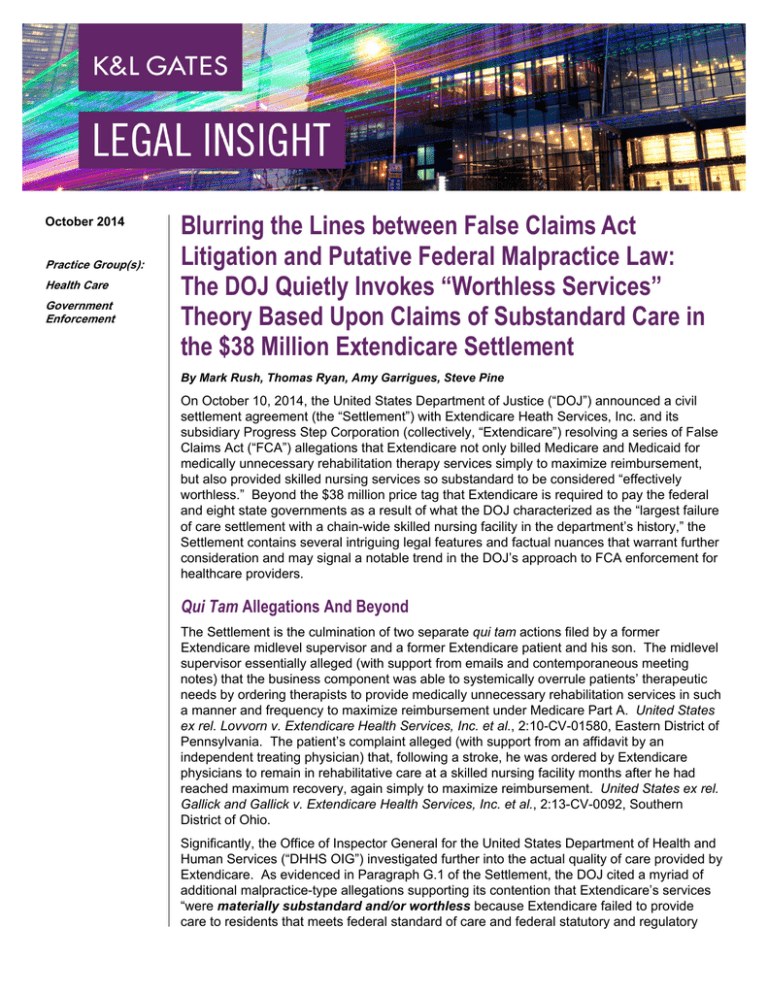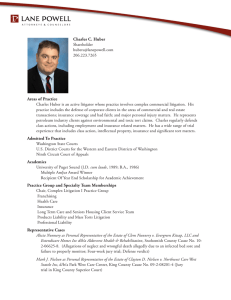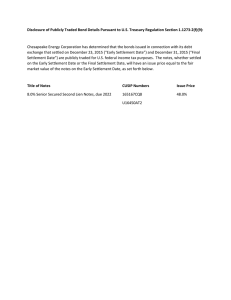
October 2014
Practice Group(s):
Health Care
Government
Enforcement
Blurring the Lines between False Claims Act
Litigation and Putative Federal Malpractice Law:
The DOJ Quietly Invokes “Worthless Services”
Theory Based Upon Claims of Substandard Care in
the $38 Million Extendicare Settlement
By Mark Rush, Thomas Ryan, Amy Garrigues, Steve Pine
On October 10, 2014, the United States Department of Justice (“DOJ”) announced a civil
settlement agreement (the “Settlement”) with Extendicare Heath Services, Inc. and its
subsidiary Progress Step Corporation (collectively, “Extendicare”) resolving a series of False
Claims Act (“FCA”) allegations that Extendicare not only billed Medicare and Medicaid for
medically unnecessary rehabilitation therapy services simply to maximize reimbursement,
but also provided skilled nursing services so substandard to be considered “effectively
worthless.” Beyond the $38 million price tag that Extendicare is required to pay the federal
and eight state governments as a result of what the DOJ characterized as the “largest failure
of care settlement with a chain-wide skilled nursing facility in the department’s history,” the
Settlement contains several intriguing legal features and factual nuances that warrant further
consideration and may signal a notable trend in the DOJ’s approach to FCA enforcement for
healthcare providers.
Qui Tam Allegations And Beyond
The Settlement is the culmination of two separate qui tam actions filed by a former
Extendicare midlevel supervisor and a former Extendicare patient and his son. The midlevel
supervisor essentially alleged (with support from emails and contemporaneous meeting
notes) that the business component was able to systemically overrule patients’ therapeutic
needs by ordering therapists to provide medically unnecessary rehabilitation services in such
a manner and frequency to maximize reimbursement under Medicare Part A. United States
ex rel. Lovvorn v. Extendicare Health Services, Inc. et al., 2:10-CV-01580, Eastern District of
Pennsylvania. The patient’s complaint alleged (with support from an affidavit by an
independent treating physician) that, following a stroke, he was ordered by Extendicare
physicians to remain in rehabilitative care at a skilled nursing facility months after he had
reached maximum recovery, again simply to maximize reimbursement. United States ex rel.
Gallick and Gallick v. Extendicare Health Services, Inc. et al., 2:13-CV-0092, Southern
District of Ohio.
Significantly, the Office of Inspector General for the United States Department of Health and
Human Services (“DHHS OIG”) investigated further into the actual quality of care provided by
Extendicare. As evidenced in Paragraph G.1 of the Settlement, the DOJ cited a myriad of
additional malpractice-type allegations supporting its contention that Extendicare’s services
“were materially substandard and/or worthless because Extendicare failed to provide
care to residents that meets federal standard of care and federal statutory and regulatory
Blurring the Lines between False Claims Act Litigation and Putative Federal
Malpractice Law: The DOJ Quietly Invokes “Worthless Services” Theory
Based Upon Claims of Substandard Care in the $38 Million Extendicare
Settlement
requirements” (emphasis added). The allegations read like a checklist for a state common
law medical malpractice lawsuit and may be expected to give rise to a second round of tort
litigation.
The DHHS OIG’s apparent willingness to dig deeper into a quality of care inquiry signals that
it is critically important that healthcare providers’ compliance departments thoroughly
investigate potential whistleblower allegations, including issues related to quality of care, and
report any concerns to the Board of Directors.1
The DOJ’s Reliance on “Substandard Care” to Invoke “Worthless Services”
Theory
Under the “worthless services” theory of FCA liability, a healthcare provider can be deemed
to have submitted a “factually false” claim if it is proven that the provider knew that the
services were so deficient that they are effectively worthless. See, e.g., United States ex rel.
Blundell v. Dialysis Clinic, Inc., No. 5:09-CV-00710 at pp. 20-21 (N.D.N.Y. Jan. 19, 2011).
The Seventh Circuit has recently added that this threshold requires more than evidence of
services with a “diminished value”—i.e., truly “worthless” services cannot merely be “worth
less.” United States ex rel. Absher v. Momence Meadows Nursing Center, Inc., 764 F.3d
699, 710 (7th Cir. 2014).
On the other hand, “substandard care” allegations generally fall under a separate “legally
false” theory and are analyzed to determine whether the healthcare provider submitted an
implied false certification. See United States ex. rel. Mikes v. Straus, 931 F. Supp. 248
(S.D.N.Y. 1996). Under this theory, a relator alleges that a healthcare provider’s
certifications implicitly and necessarily contain, as a condition for payment, a representation
that the healthcare provider has complied with Medicare or Medicaid’s legal and regulatory
standards of care. See United States v. NHC Healthcare Corp., 115 F. Supp. 2d 1149 (W.D.
Mo. 2000). Notably, courts have been loathe to embrace this “substandard care” corollary to
the “implied false certification” theory because “permitting qui tam plaintiffs to assert that
defendants’ quality of care failed to meet medical standards would promote federalization of
medical malpractice, as the federal government or the qui tam relator would replace the
aggrieved patient as the plaintiff.” Mikes, 274 F. Supp. at 700.
Yet, the DOJ adopted the “substandard care” approach in the Settlement. Further, as
quoted above, the government seemed to equate two distinct FCA theories of liability when it
alleged that Extendicare’s quality of care was “materially substandard and/or worthless.”
The Settlement and the DOJ’s announcement further suggest that when certain “essential”
Medicare and Medicaid requirements are not met when providing medical services, the
government may argue that those services have no value.
This subtle choice of language may signal a strategy on the part of the government that
could be concerning to providers. The willingness of the DOJ to recast essentially
malpractice allegations as “worthless services” has incredibly broad implications, forecasting
1
This is consistent with joint guidance from the American Health Lawyers Association (“AHLA”) and the OIG. See OIG
and AHLA, Corporate Responsibility and Corporate Compliance: A Resource for Health Care Boards of Directors,
available at: https://oig.hhs.gov/fraud/docs/complianceguidance/040203CorpRespRsceGuide.pdf.
2
Blurring the Lines between False Claims Act Litigation and Putative Federal
Malpractice Law: The DOJ Quietly Invokes “Worthless Services” Theory
Based Upon Claims of Substandard Care in the $38 Million Extendicare
Settlement
perhaps the government’s intention to pursue those claims under a more straightforward
“factually false” theory rather than the more nuanced “legally false” theory.
Corporate Integrity Agreements: Additional Costs of FCA Liability
An additional cost of the Settlement that will be borne by Extendicare comes in the form of a
five-year Corporate Integrity Agreement (“CIA”). The expansive CIA will require Extendicare
to revamp a wide range of compliance protocols, including establishing a new Compliance
Officer, Compliance Committee, and Code of Conduct Policy, and establishing certain new
staffing requirements. Essentially, Extendicare agreed to build an entirely new compliance
function from the ground up.
Further, Extendicare agreed to retain an independent quality monitor to evaluate
Extendicare’s internal quality control systems, responses to quality of care issues, proactive
steps taken to ensure resident care, compliance with staffing requirements, and more. The
Monitor is granted full and immediate access to a wide range of Extendicare documents and
records, as well as patients, plus any other data the monitor determines is relevant to
fulfilling its duties. Of particular note, the government’s focus in the CIA is again aimed most
directly at their quality of care allegations, as opposed to the overbilling allegations.
Takeaways from the Settlement
There are several important points to take away from the Settlement:
• It is important for every healthcare provider to empower its compliance function to
impartially referee what may be legitimate disputes between the business and patientservices functions of the business. A compliance department can serve as an important
filter between corporate interests and clinical decisions, to avoid even the appearance of
improper influence upon nurses and physicians. This approach will also help ensure the
compliance department detects potential FCA issues earlier.
• It is critical for the healthcare provider to conduct a thorough internal investigation once
an issue is identified that dives deeper into the allegations. The Settlement clearly shows
that the DHHS OIG is willing to do so, and of the $38 million settlement figure, $28 million
is based off of quality of care issues that were not part of either whistleblower complaint.
• Healthcare providers need to be vigilant in the government’s or relator’s attempt to crosspollinate legal theories of liability. Understanding the nuance of the government’s position
is critical to a successful litigation strategy. The subtleties of the Settlement demonstrate
the DOJ’s willingness to push the envelope—in some respect beyond the relators’ claims.
If not vigilant, healthcare providers could essentially be exposed to the equivalent of
federalized malpractice lawsuits.
• While the civil monetary penalty imposed may grab the headlines, there are additional
significant costs of resolving FCA liability in the form of CIAs.
3
Blurring the Lines between False Claims Act Litigation and Putative Federal
Malpractice Law: The DOJ Quietly Invokes “Worthless Services” Theory
Based Upon Claims of Substandard Care in the $38 Million Extendicare
Settlement
Authors:
Mark Rush
mark.rush@klgates.com
+1.412.355.8333
Thomas Ryan
thomas.ryan@klgates.com
+1.412.355.8335
Amy Garrigues
amy.garrigues@klgates.com
+1.919.466.1275
Steve Pine
steve.pine@klgates.com
+1.919.466.1188
Anchorage Austin Beijing Berlin Boston Brisbane Brussels Charleston Charlotte Chicago Dallas Doha Dubai Fort Worth Frankfurt
Harrisburg Hong Kong Houston London Los Angeles Melbourne Miami Milan Moscow Newark New York Orange County Palo Alto Paris
Perth Pittsburgh Portland Raleigh Research Triangle Park San Francisco São Paulo Seattle Seoul Shanghai Singapore Spokane
Sydney Taipei Tokyo Warsaw Washington, D.C. Wilmington
K&L Gates comprises more than 2,000 lawyers globally who practice in fully integrated offices located on five
continents. The firm represents leading multinational corporations, growth and middle-market companies, capital
markets participants and entrepreneurs in every major industry group as well as public sector entities, educational
institutions, philanthropic organizations and individuals. For more information about K&L Gates or its locations,
practices and registrations, visit www.klgates.com.
This publication is for informational purposes and does not contain or convey legal advice. The information herein should not be used or relied upon in
regard to any particular facts or circumstances without first consulting a lawyer.
© 2014 K&L Gates LLP. All Rights Reserved.
4






